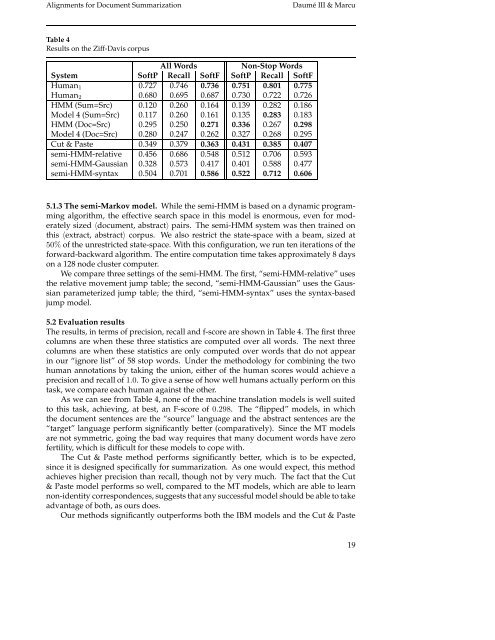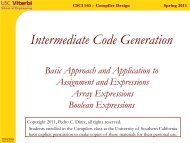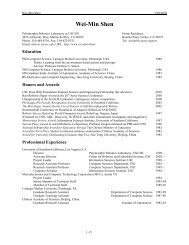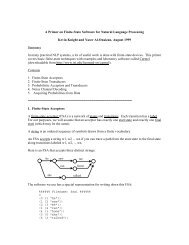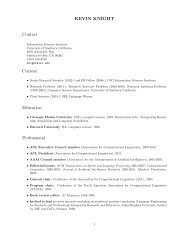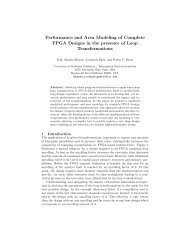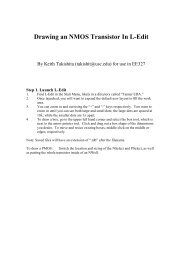Induction of Word and Phrase Alignments for Automatic Document ...
Induction of Word and Phrase Alignments for Automatic Document ...
Induction of Word and Phrase Alignments for Automatic Document ...
Create successful ePaper yourself
Turn your PDF publications into a flip-book with our unique Google optimized e-Paper software.
<strong>Alignments</strong> <strong>for</strong> <strong>Document</strong> Summarization Daumé III & Marcu<br />
Table 4<br />
Results on the Ziff-Davis corpus<br />
All <strong>Word</strong>s Non-Stop <strong>Word</strong>s<br />
System S<strong>of</strong>tP Recall S<strong>of</strong>tF S<strong>of</strong>tP Recall S<strong>of</strong>tF<br />
Human1 0.727 0.746 0.736 0.751 0.801 0.775<br />
Human2 0.680 0.695 0.687 0.730 0.722 0.726<br />
HMM (Sum=Src) 0.120 0.260 0.164 0.139 0.282 0.186<br />
Model 4 (Sum=Src) 0.117 0.260 0.161 0.135 0.283 0.183<br />
HMM (Doc=Src) 0.295 0.250 0.271 0.336 0.267 0.298<br />
Model 4 (Doc=Src) 0.280 0.247 0.262 0.327 0.268 0.295<br />
Cut & Paste 0.349 0.379 0.363 0.431 0.385 0.407<br />
semi-HMM-relative 0.456 0.686 0.548 0.512 0.706 0.593<br />
semi-HMM-Gaussian 0.328 0.573 0.417 0.401 0.588 0.477<br />
semi-HMM-syntax 0.504 0.701 0.586 0.522 0.712 0.606<br />
5.1.3 The semi-Markov model. While the semi-HMM is based on a dynamic programming<br />
algorithm, the effective search space in this model is enormous, even <strong>for</strong> moderately<br />
sized 〈document, abstract〉 pairs. The semi-HMM system was then trained on<br />
this 〈extract, abstract〉 corpus. We also restrict the state-space with a beam, sized at<br />
50% <strong>of</strong> the unrestricted state-space. With this configuration, we run ten iterations <strong>of</strong> the<br />
<strong>for</strong>ward-backward algorithm. The entire computation time takes approximately 8 days<br />
on a 128 node cluster computer.<br />
We compare three settings <strong>of</strong> the semi-HMM. The first, “semi-HMM-relative” uses<br />
the relative movement jump table; the second, “semi-HMM-Gaussian” uses the Gaussian<br />
parameterized jump table; the third, “semi-HMM-syntax” uses the syntax-based<br />
jump model.<br />
5.2 Evaluation results<br />
The results, in terms <strong>of</strong> precision, recall <strong>and</strong> f-score are shown in Table 4. The first three<br />
columns are when these three statistics are computed over all words. The next three<br />
columns are when these statistics are only computed over words that do not appear<br />
in our “ignore list” <strong>of</strong> 58 stop words. Under the methodology <strong>for</strong> combining the two<br />
human annotations by taking the union, either <strong>of</strong> the human scores would achieve a<br />
precision <strong>and</strong> recall <strong>of</strong> 1.0. To give a sense <strong>of</strong> how well humans actually per<strong>for</strong>m on this<br />
task, we compare each human against the other.<br />
As we can see from Table 4, none <strong>of</strong> the machine translation models is well suited<br />
to this task, achieving, at best, an F-score <strong>of</strong> 0.298. The “flipped” models, in which<br />
the document sentences are the “source” language <strong>and</strong> the abstract sentences are the<br />
“target” language per<strong>for</strong>m significantly better (comparatively). Since the MT models<br />
are not symmetric, going the bad way requires that many document words have zero<br />
fertility, which is difficult <strong>for</strong> these models to cope with.<br />
The Cut & Paste method per<strong>for</strong>ms significantly better, which is to be expected,<br />
since it is designed specifically <strong>for</strong> summarization. As one would expect, this method<br />
achieves higher precision than recall, though not by very much. The fact that the Cut<br />
& Paste model per<strong>for</strong>ms so well, compared to the MT models, which are able to learn<br />
non-identity correspondences, suggests that any successful model should be able to take<br />
advantage <strong>of</strong> both, as ours does.<br />
Our methods significantly outper<strong>for</strong>ms both the IBM models <strong>and</strong> the Cut & Paste<br />
19


